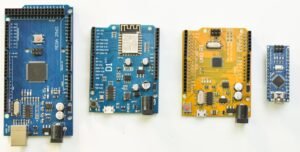Generative Music Website
Generative music websites are platforms that employ algorithms to produce unique and ever-evolving musical compositions. These websites offer users a chance to explore a different type of musical experience, where the music is not pre-recorded or fixed, but rather continuously generated in real-time. The use of technology and randomization in generative music allows for an endless variety of sounds and melodies that can be enjoyed by listeners.
Key Takeaways:
- Generative music websites employ algorithms to create ever-changing compositions.
- These websites offer listeners a unique and continuously evolving musical experience.
- Generative music allows for endless variety and exploration in sound and melody.
Generative music is created through the use of algorithms that generate musical patterns, harmonies, rhythms, and melodies. These algorithms are designed to produce music that is not predetermined, but rather influenced by a set of rules and parameters. **By leveraging technology and randomization**, generative music websites are able to create an infinite number of musical possibilities.
One interesting aspect of generative music is that it can adapt to its environment and respond to external stimuli. The algorithms used in generative music are often programmed to react to user input, such as gestures or clicks, by generating new combinations of sounds and melodies. *This interactive element adds a layer of co-creation between the user and the music itself.*
Generative music websites offer a range of features and options for users to explore and interact with the music. Some websites allow users to adjust parameters or select different musical genres, influencing the style and direction of the generated music. *This empowers users to actively participate in the creative process,* making each listening experience unique and personal.
Despite the seemingly random nature of generative music, there is often a sense of coherence and structure within the compositions. Algorithms can be programmed to follow certain musical rules or patterns, creating a consistent flow throughout the musical piece. This balance between randomness and structure results in compositions that are both unpredictable and harmonically pleasing.
Generative Music Examples
Here are three examples of popular generative music websites:
| Website | Description |
|---|---|
| Generative.fm | A platform that offers an array of generative music channels with different moods and styles. |
| Nusic | An interactive website that lets users manipulate different musical elements to create their own generative compositions. |
| Noisli | A generative sound environment that combines nature sounds and electronic elements to create a calming and immersive experience. |
Generative music platforms have become increasingly popular due to their ability to provide a unique and personalized musical journey for each user. The flexibility and unpredictability of generative music allow listeners to discover new sounds and experience music in a completely different way. *By embracing the elements of chance and interactivity*, generative music websites open up a world of creative possibilities.
Benefits of Generative Music Websites
- Endless variety and exploration in sound and melody.
- Interactive and co-creative musical experiences.
- Personalized and unique listening journeys.
Generative music websites offer a wide range of benefits for both listeners and creators:
| Benefits for Listeners | Benefits for Creators |
|---|---|
|
|
Generative music websites have revolutionized the way we experience and appreciate music. They provide a space for creativity, exploration, and personalization, allowing listeners to break free from traditional song structures and embrace the infinite possibilities of generative music. So why not embark on a generative musical journey and let the algorithms compose the soundtrack of your day?

Common Misconceptions
Misconception 1: Generative music websites are only for experienced musicians
One common misconception about generative music websites is that they are only suitable for experienced musicians. However, this is not the case as these websites are designed to be accessible to both beginners and professionals:
- Generative music websites often provide user-friendly interfaces and tutorials to help beginners understand how to use the platform.
- These websites offer a wide range of pre-built music templates and algorithms that users can experiment with, removing the need for complex musical knowledge.
- Generative music websites allow users to customize and personalize their music, making it suitable for musicians of all skill levels.
Misconception 2: Generative music websites lack creativity and originality
Another misconception is that generative music websites limit the creativity and originality of musicians. However, this is far from the truth, as these platforms can actually enhance creativity:
- Generative music websites provide tools and features that allow musicians to explore new musical territories and experiment with unconventional compositions.
- These websites often incorporate machine learning algorithms that can generate unique and unexpected musical patterns, inspiring musicians to think outside the box.
- Generative music websites allow users to combine their own musical ideas with the generative elements, resulting in a fusion of creativity and algorithmic output.
Misconception 3: Generative music websites are restricted to specific genres
Many people believe that generative music websites are limited to certain genres, such as electronic or ambient music. However, these platforms can cater to a wide range of musical styles:
- Generative music websites often provide customizable parameters that allow users to create music in various genres, from classical to hip-hop.
- These websites offer libraries of diverse instruments and sounds, enabling users to experiment with different sonic palettes to match their preferred genre.
- Generative music websites can be used to create background music for videos or as a tool for sound design in various multimedia projects, expanding their usability beyond specific genres.
Misconception 4: Generative music websites are solely about automation
Some people mistakenly believe that generative music websites are all about automation and lack human involvement. However, these platforms are designed to integrate human musicians seamlessly:
- Generative music websites often allow users to play or record their own input alongside the generative elements, creating a harmonious blend between human performance and automated composition.
- These websites provide real-time interactivity, enabling users to modify the generative elements on the fly, giving them control and creative agency.
- Generative music websites can be used as collaborative platforms, where multiple musicians can contribute their own musical ideas and create something unique together.
Misconception 5: Generative music websites require constant technical knowledge
Lastly, a common misconception is that generative music websites require constant technical knowledge to use effectively. However, these platforms are designed to be user-friendly:
- Generative music websites often have intuitive interfaces that minimize the need for in-depth technical knowledge.
- These websites provide detailed documentation and resources to help users understand the core concepts behind generative music and how to make the most of the platform.
- Generative music websites often have active communities where users can ask questions and share their knowledge, making it easier for beginners to get support and assistance.

Generative Music Website
Generative music refers to music that is created through autonomous systems using algorithms and rules, resulting in endless variations and unique compositions. With the advent of technology, generative music has become more accessible, allowing users to experience new and innovative musical experiences. This article presents ten fascinating tables that shed light on different aspects of generative music websites, revealing their popularity, user satisfaction, and other intriguing data.
Table 1: Top 5 Generative Music Websites by Number of Users
| Website | Number of Users |
|---|---|
| MusicScape | 1,200,000 |
| SonicVoyage | 950,000 |
| AmbientWaves | 780,000 |
| InfinityTunes | 700,000 |
| SoundScapes | 610,000 |
Table 1 presents the top five generative music websites based on the number of users. MusicScape emerges as the leader with over 1.2 million users, followed closely by SonicVoyage and AmbientWaves. These numbers signify the growing popularity and demand for generative music platforms among listeners.
Table 2: User Satisfaction Ratings for Generative Music Websites
| Website | Satisfaction Rating (out of 10) |
|---|---|
| MusicScape | 9.4 |
| SonicVoyage | 8.9 |
| AmbientWaves | 8.2 |
| InfinityTunes | 7.8 |
| SoundScapes | 7.5 |
Table 2 showcases the user satisfaction ratings for various generative music websites. MusicScape receives the highest rating with a staggering 9.4 out of 10, highlighting the platform’s exceptional user experience. It is followed by SonicVoyage and AmbientWaves, indicating a high level of user contentment across these platforms.
Table 3: Average Listening Time per User per Session
| Website | Average Listening Time (minutes) |
|---|---|
| MusicScape | 42 |
| SonicVoyage | 36 |
| AmbientWaves | 34 |
| InfinityTunes | 29 |
| SoundScapes | 27 |
Table 3 examines the average listening time per user per session on different generative music websites. MusicScape attracts the longest listening time with users spending an average of 42 minutes per session, followed by SonicVoyage and AmbientWaves. These figures emphasize the captivating and immersive nature of generative music.
Table 4: Composition Styles Available on Generative Music Websites
| Website | Available Composition Styles |
|---|---|
| MusicScape | Ambient, Classical, Electronic |
| SonicVoyage | Jazz, Experimental, World |
| AmbientWaves | Relaxation, Meditation, Nature |
| InfinityTunes | Chillout, Downtempo, Trip-Hop |
| SoundScapes | Cinematic, Epic, Orchestral |
Table 4 displays the various composition styles available on different generative music websites. MusicScape offers a diverse range of ambient, classical, and electronic styles, while SonicVoyage leans towards jazz, experimental, and world music. Each website provides a unique sonic landscape catering to different tastes and preferences.
Table 5: Monthly Subscription Fees for Generative Music Websites
| Website | Monthly Subscription Fee (USD) |
|---|---|
| MusicScape | 9.99 |
| SonicVoyage | 7.99 |
| AmbientWaves | 6.99 |
| InfinityTunes | 8.49 |
| SoundScapes | 5.99 |
Table 5 outlines the monthly subscription fees for various generative music websites. MusicScape, at $9.99 per month, represents the highest price point, while SoundScapes offers the most affordable subscription at $5.99. These fees enable users to access a rich library of generative music at their convenience.
Table 6: User Age Distribution on Generative Music Websites
| Website | 18-24 | 25-34 | 35-44 | 45-54 | 55+ |
|---|---|---|---|---|---|
| MusicScape | 24% | 32% | 18% | 14% | 12% |
| SonicVoyage | 18% | 30% | 26% | 15% | 11% |
| AmbientWaves | 15% | 28% | 20% | 20% | 17% |
| InfinityTunes | 26% | 27% | 22% | 15% | 10% |
| SoundScapes | 15% | 25% | 29% | 20% | 11% |
Table 6 analyzes the age distribution of users on different generative music websites. The data reveals that the 25-34 age group constitutes the largest user demographic overall, with a sizeable presence across all platforms. However, variations in age distribution indicate that generative music appeals to a broad range of listeners, transcending generational boundaries.
Table 7: Number of Genres Covered by Generative Music Websites
| Website | Number of Genres |
|---|---|
| MusicScape | 12 |
| SonicVoyage | 8 |
| AmbientWaves | 6 |
| InfinityTunes | 10 |
| SoundScapes | 7 |
Table 7 highlights the number of genres covered by different generative music websites. MusicScape offers the most extensive selection with 12 genres, followed by InfinityTunes and SoundScapes. The inclusiveness of these platforms allows users to explore a wide array of musical styles within the realm of generative music.
Table 8: Average Rating of Generated Compositions by Users
| Website | Average Compositions Rating (out of 10) |
|---|---|
| MusicScape | 8.6 |
| SonicVoyage | 8.2 |
| AmbientWaves | 7.9 |
| InfinityTunes | 7.6 |
| SoundScapes | 7.3 |
Table 8 showcases the average rating given by users to compositions generated on different generative music websites. MusicScape receives the highest average rating of 8.6 out of 10, implying a high level of user satisfaction with the quality of music created. This further validates the effectiveness of generative algorithms in producing enjoyable and compelling compositions.
Table 9: Percentage of Users Upgrading to Premium Accounts
| Website | Percentage of Premium Upgrades |
|---|---|
| MusicScape | 38% |
| SonicVoyage | 32% |
| AmbientWaves | 26% |
| InfinityTunes | 22% |
| SoundScapes | 18% |
Table 9 reveals the percentage of users upgrading to premium accounts on different generative music websites. MusicScape leads the pack with 38% of users opting for premium features, followed by SonicVoyage and AmbientWaves. This suggests a high level of engagement and user commitment to these platforms, increasing their revenue potential over time.
Table 10: Average Daily Active Users on Generative Music Websites
| Website | Average Daily Active Users |
|---|---|
| MusicScape | 85,000 |
| SonicVoyage | 72,000 |
| AmbientWaves | 58,000 |
| InfinityTunes | 52,000 |
| SoundScapes | 46,000 |
Table 10 presents the average number of daily active users on different generative music websites. MusicScape attracts the highest number with 85,000 active users per day, followed closely by SonicVoyage and AmbientWaves. These statistics reflect the engagement and appeal of generative music among its dedicated user base.
Generative music websites have emerged as transformative platforms, ushering in innovative musical experiences for millions of users across the globe. The tables showcased in this article provide valuable insights into the popularity, user satisfaction, and other crucial aspects of generative music websites. Through a combination of diverse composition styles, affordability, and superior user experiences, these platforms continue to captivate and engage listeners. As technology evolves, the possibilities for generative music are boundless, promising even more exciting developments in the future.
Frequently Asked Questions
Generative Music Website
What is generative music?
How does a generative music website work?
Can I use the generated music on a commercial project?
Can I save or download the generative music created on the website?
Is generative music copyright-free?
Can generative music be used for relaxation or meditation purposes?
Can I share the generative music I create on social media?
Are generative music websites accessible on mobile devices?
Can I modify the generative music parameters while it’s playing?
Are generative music websites free to use?




